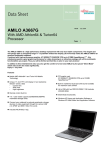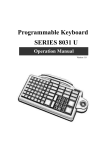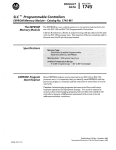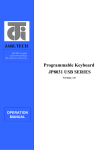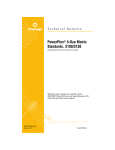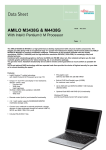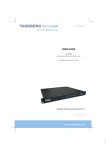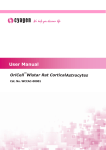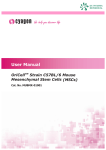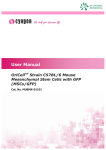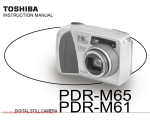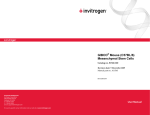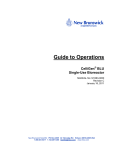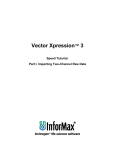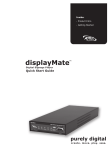Download User Manual - Cyagen Biosciences
Transcript
User Manual OriCellTMStrain C57BL/6 MouseMesenchymal Stem Cells with RFP(MSCs/RFP) Cat. No. MUBMX-01201 Table of Contents ContentsandStorage………………………………………………………………………………………3 ProductIntroduction………………………………………………………………………………………3 CellCharacteristicsandIdentity………………………………………… ……………………………3 ProductApplication………………………………………………………… ………………………………4 GeneralHandlingPrinciples……………………………………………………………………………4 CulturingOriCellTMStrain C57BL/6 Mouse MSCs/RFP ThawingandEstablishingOriCell TM Strain C57BL/6 Mouse MSCs/RFP……………………4 TM PassagingCyagenOriCell Strain C57BL/6 Mouse MSCs/RFP………………………………6 TM DifferentiationofOriCell Strain C57BL/6 Mouse MSCs/RFP…………………………………7 TM Cryopreservation ofOriCell Strain C57BL/6 Mouse MSCs/RFP……………………………11 Appendix………………………………………………………………………………..13 Troubleshooting………………………………………………………………………………………………13 RelatedProducts……………………………………………………………………………………………14 References…………………………………………………………………………………………………14 Technical Support ………………………………………………………………..……15 CONTENTS AND STORAGE Product Name Strain C57BL/6 Mouse Mesenchymal Stem Cells with RFP Catalog No. MUBMX-01201 Amount per Vial 1×106 Cells Cryopreserved At Ninth Passage Storage Condition Liquid Nitrogen CAUTION:Please handle this product as a potentiallybiohazardous material. This product contains dimethyl sulfoxide (DMSO), a hazardous material, in the freezing medium. PRODUCT INTRODUCTION Mesenchymal stem cells (MSCs) are multipotent stem cells that can differentiate into a variety of cell typesincluding osteocytes, adipocytes, and chondrocytes. MSCs proliferate quickly and are capable of generating a local immunosuppressive microenvironment, thus contributing to their wide application potentials in tissue engineering, cell therapy, and gene therapy. OriCellTMC57BL/6Mesenchymal Stem Cells with RFP are derived from the bone marrow of C57BL/6 mice, cultured as monolayer, and then have been transfected with a lentiviral construct containing a RFP expression motif. They have a strong capacity for self-renewal while maintaining their multipotency. In addition, these cells have been tested for: Exogenous Factors:bacterial/fungal contamination, mycoplasma contamination, and endotoxin contamination. Characteristics:post-thaw viability, cell cycle, verification of undifferentiated state, and differentiation potential. This product is intended for laboratory research use only. It is not intended for diagnostic, therapeutic, clinical, household, or any other applications. IMPI0076A3 MUBMX-01201 Page 3 of 15 CELL CHARACTERISTICS AND IDENTITY Strong capacity to expand. Can be passaged at least 5 times. Multipotent differentiation ability along theosteogenic, chondrogenic, and adipogenic lineages. Positive for CD29, CD44, CD31, and Sca-1 (> 70%), and negative for CD117 (< 5%) in flow cytometry assays. PRODUCT APPLICATIONS Strain C57BL/6 Mouse MSCs/RFP have become a popular research target due to their potential use in regenerative medicine and tissue engineering (in areas such as cardiovascular, neural, and orthopedic disease). OriCellTMStrain C57BL/6 Mouse MSCs/RFP can be used as cell models to evaluate the immunoreactions, proliferation, immigration, and differentiation of MSCs both in vivo and in vitro. GENERAL HANDLING PRINCIPLES 1. Aseptic handling of the product is necessary throughout. 2. Once the cells have been established, always freeze several vials of OriCellTMStrain C57BL/6 Mouse MSCs/RFP as a backup. Note:TheOriCellTMStrain C57BL/6 Mouse MSCs/RFP can be frozen/thawed at least two times. 3. For all studies, it is strongly recommended to use cells that are at, or under, an original passage number of 10. 4. For general maintenance of cells, we recommend the seeding density to be 2.03.0×104cells/cm2. 5. For general maintenance of cells, we recommend that the mediumis changed ifit becomes acidic (the pH indicator in the medium appears yellow). In general, change the growth medium every three days. 6. Do not let OriCellTMC57BL/6 MSCs/RFPovergrow as it will result in contact inhibition. When the cells are 80-90%confluent,subculturing the cells is strongly recommended. Note:We strongly recommend the use ofOriCellTM culture media and other related reagents for optimal results. IMPI0076A3 MUBMX-01201 Page 4 of 15 TM THAWING AND ESTABLISHING OriCell Strain C57BL/6 Mouse MSCs/RFP Materials Required OriCellTMMouseMesenchymal Stem Cell Growth Medium(Cat. No.MUXMX-90011) Thawing and Establishing Strain C57BL/6 Mouse MSCs/RFP 1. Pre-warm the fully supplemented (complete)OriCellTM Mouse MSC Growth Medium to 37°C. 2. Add 9 mL of OriCellTM Mouse MSC Growth Medium to a 15 mLconical tube. 3. Remove the cryovial of OriCellTMStrain C57BL/6 Mouse MSCs/RFP from liquid nitrogen. 4. Quickly thaw the cryovialina 37°C water bath until the last icecrystaldisappears. For optimal results, be sure to finish the thawing procedure within 3 minutes. Be careful not to submerge the entire vial. Maximum cell viability is dependent on the rapid and complete thawing of frozen cells. Note:Results will be less than optimal if the cells are thawed for more than 3 minutes. 5. As soon as the cells are completely thawed, disinfect the outside of the cryovial with 70% v/v ethanol. 6. Use a pipette to transfer the cells to the 15 mL conical tube containing OriCellTM Mouse MSC Growth Medium inside a biosafety cabinet. Be careful not to introduce any bubbles during the transfer process. 7. Rinse the vial with 1 mL of the medium to reduce cell loss. Subsequently transfer this 1 mL of cell suspension into the conical tube. 8. Gently mix the cell suspension by slowly pipetting up and down. Be careful not to introduce any bubbles. 9. Centrifuge the cell suspension at 250 x g for 5 minutes. 10. Carefully aspirate off as much of the supernatant as possible and add 2-3 mL of fresh OriCellTM Mouse MSC Growth Medium (pre-warmed to 37°C). 11. Gently resuspend the cells in OriCellTM Mouse MSC Growth Medium. 12. Seed the cells into a T25 flask and add a sufficient amount ofOriCellTM Mouse MSC Growth Medium. Gentlyrock the culture flask to evenly distribute the cells. 13. Incubate the flask at 37°C inside a 5% CO2 humidified incubator. 14. The next day, change the medium with fresh growth medium (pre-warmed to 37°C). 15. Change the growth medium every three days thereafter. 16. When the cells are approximately 80-90% confluent, they can be dissociated with Trypsin-EDTA and passaged. Note: Changing Medium IMPI0076A3 MUBMX-01201 Page 5 of 15 1. Warm an appropriate amount of medium to 37°C in a sterile container. Replace the spent medium with the pre-warmed, fresh medium. Once completed, return the flask to the incubator. 2. Avoid repeated warming and cooling of the medium. If the entire content is not needed for a single procedure, transfer only the required volume to a sterile secondary container. Fig. 1. OriCellTMStrain C57BL/6 MouseMesenchymal Stem Cells with RFP are established. PASSAGING OriCellTMStrain C57BL/6 MouseMSCs/RFP Materials Required 0.25%Trypsin-0.04%EDTA(Cat. No. TEDTA-10001) Phosphate-BufferedSaline (1×PBS) (Cat. No. PBS-10001) OriCellTMStrain C57BL/6 MouseMesenchymal Stem Cellswith RFP(Cat. No. MUBMX01201) OriCellTMMouseMesenchymal Stem Cell Growth Medium(Cat. No. MUXMX-90011) Passaging OriCellTMStrain C57BL/6 MouseMSCs/RFP 1. Pre-warm the OriCellTM Mouse MSC Growth Medium, 1×PBS, and 0.25%Trypsin0.04%EDTA solution to 37°C. 2. Carefully aspirate the spent medium from the 80-90% confluent monolayer of MSCs. 3. Add 1×PBS (6 mL for T75 flask, 3 mL for T25 flask). Be careful not to disturb the monolayer. Gently rock the flask back and forth to rinse the monolayer. 4. Aspirate 1×PBS off and discard. 5. Repeat steps 3-4 two or three times. 6. Add 0.25%Trypsin-0.04%EDTA solution (2-3 mL for T75 flask, 1 mL for T25 flask). Gently rock the flask back and forth to ensure that the entire monolayer is covered with the Trypsin-EDTA solution. Allow trypsinization to continue until the majority of the cells (approximately80%) are rounded up. At this point, gently tap the side of the flask to release the majorityof cells from the culture flask surface. IMPI0076A3 MUBMX-01201 Page 6 of 15 Important:Avoid leaving cells exposed to the trypsin longer than necessary (no more than two minutes if using Cyagen’s trypsin-EDTA solution). Care should also be taken that the cells are not forced to detach prematurely as this may result in clumping. 7. After the cells are visibly detached, immediately add the pre-warmedOriCellTM Mouse MSC Growth Medium(6 mL for T75 flask, 3 mL for T25 flask) to neutralize the trypsinization. 8. Gently pipette the medium over the cells to dislodge and resuspend the cells. Repeat 5-6times until all the cells are dissociated from the flask and evenly dispersed into a singlecell suspension. 9. Transfer the dissociated cells into a 15 mL conical tube. 10. Centrifuge at 250 x g for 5 minutes. 11. Carefully aspirate off as much of the supernatant as possible. 12. Add 2 mL of OriCellTM Mouse MSC Growth Medium to the conical tube and gently resuspend the cells thoroughly. 13. Plate the cells into appropriate flasks. OriCellTMStrain C57BL/6 MouseMSCs/RFP can be split at1:2 or other appropriate ratios. 14. Add an appropriate amount of medium to the cells.Incubate the cells at 37°C inside a 5% CO2humidified incubator. Note:Care should be taken to avoid introducing bubbles during pipetting. Additional Tips Time to Change Medium It is recommended to change the culture medium if there are too many dead cells after passaging. It is recommended to change the culture medium whenever the medium becomes acidic, even if the cells do not reach 80-90% confluency. The pH indicator in the culture medium will appear yellow when acidic. Time to Subculture WhenOriCellTMStrain C57BL/6 Mouse MSCs/RFPare8090%confluent,itisrecommendedthatthecellsbesubcultured. Do not let the cells overgrow as it will result in contact inhibition. OriCellTMStrain C57BL/6 Mouse MSCs DIFFERENTIATION USING OriCellTM DIFFERENTIATION MEDIA OriCellTMStrain C57BL/6 Mouse MSCs/RFP can differentiate into a variety of cell types including osteocytes, adipocytes, and chondrocytes. OsteogenicDifferentiation IMPI0076A3 MUBMX-01201 Page 7 of 15 Materials Required OriCellTMMesenchymal Stem Cell Osteogenic Differentiation Medium(Cat. No. GUXMX90021) Osteogenesis Protocol Note:The protocol listed below is for 6-well tissue culture plates. 1. Culturethe OriCellTMStrain C57BL/6 Mouse MSCs/RFP in OriCellTMMesenchymal Stem Cell Growth Mediumat 37°Cin a 5% CO2humidified incubator. 2. When cells are approximately 80-90% confluent, they can be dissociated with 0.25%Trypsin-0.04%EDTA (Cat. No. TEDTA-10001). 3. Reseed the MSCs in the growth medium at 3×104cells/cm2in a 6-well tissue culture plate pre-coated with 0.1% gelatin solution. 4. Incubate the cells at 37°C inside a 5% CO2humidified incubator. 5. When cells are approximately 60-70% confluent, carefully aspirate off the growth medium from each well and add 2 mL of OriCellTMMesenchymal Stem Cell Osteogenic Differentiation Medium. 6. Feed cells every three days for 2-4 weeks by completely replacing the medium with fresh OriCellTMMesenchymal Stem Cell Osteogenic Differentiation Medium (prewarmed to 37°C). 7. After 2-4 weeks of differentiation, cells can be fixed and stained with alizarin red S. Note:To prevent osteoblasts from detaching, it is recommended to change half of the medium every two days before analysis. Alizarin Red S Staining Analysis 1. After the cells have differentiated, remove the osteogenic differentiation medium from the wells and rinse with1x phosphate-buffered saline (PBS). Fix cells with 2 mL of 4% formaldehyde solution for 30 minutes. 2. Rinse wells twice with 1x PBS. Stain the cells with 1 mL alizarin red S working solution for3-5 minutes. 3. Rinse wells 2-3 times with 1x PBS. 4. Cells can now be visualized and analyzed under a microscope. IMPI0076A3 MUBMX-01201 Page 8 of 15 Fig. 3OriCellTMStrain C57BL/6 MouseMSCs/RFP are differentiated into osteocytes andare stained with alizarin red S. Adipogenic Differentiation Materials Required OriCellTMMesenchymal Stem Cell Adipogenic Differentiation Medium(Cat. No. GUXMX90031) Adipogenesis Protocol Note:The protocol listed below is for 6-well tissue culture plates. 1. Culture the OriCellTMStrain C57BL/6 Mouse MSCs/RFP in the OriCellTMMesenchymal Stem Cell Growth Medium at 37°Cin a 5% CO2humidified incubator. 2. When cells are approximately 80-90% confluent, they can be dissociated with 0.25%Trypsin-0.04% (Cat. No. TEDTA-1000). 3. Reseed the MSCsin growth medium at 2x104 cells/cm2 in a 6-well tissueculture plate with a medium volume of 2 mL per well. 4. Incubate the cells at 37°C in a 5% CO2humidified incubator. 5. Feed the cells every three days until they are 100% confluent or post-confluent. Induction of adipogenic differentiation at post-confluency is strongly recommended. 6. When the cells are 100% confluent or post-confluent, carefully aspirate off the spent growth medium from the wells and add 2 mL of OriCell TMMesenchymal Stem Cell Adipogenic Differentiation medium A (induction medium) per well. 7. Three days later, change the medium to OriCellTMMesenchymal Stem Cell Adipogenic Differentiation medium B (maintenance medium) by completely replacing the spent medium A. 8. 24 hours later, change the medium back to MSC Adipogenic Differentiation medium A. 9. To optimally differentiate MSCs into adipogenic cells, repeat the cycle of induction and maintenance at least three times. 10. After three to five cycles of induction and maintenance, culture the cells in OriCellTMMesenchymal Stem Cell Adipogenic Differentiation medium B for an IMPI0076A3 MUBMX-01201 Page 9 of 15 additional 4-7 days until the lipid droplets are big, round enough. During these days period, change the medium every three days. Oil Red O Stain Analysis 1. After the cells have differentiated, remove the MSC maintenance medium from the wells and rinse with1x phosphate-buffered saline (PBS). Fix cells with 2 mL of 4% formaldehyde solution for 30 minutes. 2. Rinse wells twice with 1x PBS and stain cells with 1 mL of oil red O working solution(3:2 dilution with distilled water and filter with filter paper) for 30 minutes. 3. Rinse wells 2-3 times with 1x PBS. 4. Cells can now be visualized and analyzed under a microscope. Fig.4OriCellTMStrain C57BL/6 MouseMSCs/RFP are differentiated into adipocytes andare stained with oil red O. Chondrogenic Differentiation Materials Required OriCellTMMesenchymal Stem Cell Chondrogenic Differentiation Medium (Cat. No. GUXMX-90041) Chondrogenesis Protocol 1. Calculate the total number of MSC pellet cultures required for your experiment (2.5×105MSCs are needed to form each chondrogenic pellet). Transfer this amount of cells into an appropriate culture tube. 2. Wash the MSCs with Incomplete Chondrogenic Medium.Centrifuge the cells at 150 x g for5 minutes at room temperature and then aspirate off the supernatant. Resuspend the cells in 1 mL of Incomplete Chondrogenic Medium per 7.5×105cells. Centrifuge again at 150 x g for 5 minutes and then aspirate off the medium. 3. Resuspend the MSCs in Complete Chondrogenic medium to a concentration of 5.0×105cells/mL. IMPI0076A3 MUBMX-01201 Page 10 of 15 4. Aliquot 0.5 mL (2.5×105cells) of the cell suspension into 15 mL polypropylene culture tubes. Centrifuge the cells at 150 x g for 5 minutes at room temperature. DO NOT aspirate the supernatant or resuspend the pellet. 5. Loosen the caps of the tubes one half turn in order to allow gas exchange, and incubate the tubesat 37°C in a humidified atmosphere of 5% CO2.Do not disturb the pellets for 24 hours. 6. Feed the cell pellets every 2-3 days by completely replacing the medium in each tube (to avoid aspirating the pellets when aspirating the medium, attach a sterile 1200μL pipette tip to the end of the aspirating pipette). Add 0.5 mL of freshly prepared Complete Chondrogenic Medium to each tube. 7. After replacing the medium, flick the bottom of the tube to ensure that the pellet is freefloating. Loosen the caps and return the tubes to the 37°C incubator. 8. Chondrogenic pellets should be harvested after 14-28 days in culture. Pellets may beformalin-fixed and paraffin-embedded for alcian blue stain analysis. Alcian Blue Staining Procedure 1. The tissue sample should be formalin-fixed and paraffin-embedded already. 2. Staining procedure: a) Deparaffinize slides and hydrate to distilled water. b) Stain in alcian blue solution for 30 minutes. c) Wash in running tap water for 2 minutes. d) Rinse in distilled water. e) Visualize under a light microscope and capture images for analysis. Blue staining indicates synthesis of proteoglycans by chondrocytes. Fig.5OriCellTMStrain C57BL/6 Mouse MSCs/RFP are differentiated into cartilages and are stained with alcian blue. IMPI0076A3 MUBMX-01201 Page 11 of 15 CRYOPRESERVATION OF CELLS USING OriCellTMCRYOPRESERVATION MEDIA OriCellTMNCR Protein-Free Cryopreservation Medium (Cat. No. NCPF-10001) is a protein-free, ready-to-use freezing medium. Itschemically-definedandproteinfreeformulationhas beenoptimizedtostemcellsandprimarycells,thusgreatlyenhancingtheviabilityand integrityofthesecellsbyprotectingthemfromdamageduringtheone-stepfreeze-thaw procedure.Unlikeotherconventionalfreezingmedia,whichrequireaslowprogrammedfreeze, thisproductallowsthecells tobedirectly frozen at -80°C. Cryopreservation Note:Change the culture medium with fresh growth medium 24 hours before freezing. 1.Collectcellsthat are in thelogarithmicgrowthphase.Performa cell counttodeterminetheviablecell density. 2.Centrifugethecellsfor3-5minutesat250 x gand20°C.Removeanddiscardthe supernatantusingapipette. 3.Resuspendthecell pelletintheOriCellTMNCRProtein-FreeCryopreservationMediumatacell density of105-106cells/mL. 4.Dispensealiquotsofthecell suspensionintocryogenicstoragevialsthatareproperly labeled. 5.Placethevialsdirectlyina -80°Cfreezer.After24hours,transferthefrozenvialstoliquid nitrogenforlong-termpreservation. IMPI0076A3 MUBMX-01201 Page 12 of 15 APPENDIX Troubleshooting The table below lists some potential problems and solutions for culturing MSCs. Problem Low cell recovery rate Cause Solution The storage condition does not meet the requirements Purchase a replacement and store in liquid nitrogen for long-term preservation. Thawing of the cells takes too long Thaw cells forno more than 3 minutes. Cells are incompletely recovered after thawing After aspirating off medium, wash the tube with culture medium twice and transferallof the cells to the dish. Cells are handled roughly Care should be taken to avoid introducing bubbles during pipetting. Also avoid vortexingand high-speed centrifugation Medium is not pre-warmed Warm medium to 37°C before recovery. Mycoplasma contamination Discard the cells in question and disinfect the laboratory environment before recovering the next batch of cells. Slow cell growth Over digestion Wash the cells with PBS 2-3 times to remove serum prior to trypsinization(serum will inhibit the function of trypsin). Control thedigestion time. Plating density is too low Inappropriate serum and medium Cell aging IMPI0076A3 MUBMX-01201 Increase the plating density. Use Cyagen tailor-made culture media. Ifother serum and media products are used, please perform validation to ensure compatibility. Dead cells are not removed promptly Change the medium next day after recovery to ensure removal of all dead cells. Cell Contamination Discard the cells in question and disinfect the laboratory environment before recovering the next batch of cells. Plating density is too low Some stem cells can secrete factors to support cell growth. Therefore, a certain degree of plating density must be maintained;otherwise, it will lead to cell proliferation slow down and cell aging. Page 13 of 15 Wash the cells with PBS 2-3 times toremove serum prior to trypsinization (serum will inhibit the function of trypsin). Over digestion Cell aging Cells show spontaneous differentiation Ineffective induction of cell differentiation Control thedigestion time. The passaging time is not appropriate The cells should be subcultured when reaching 80-90% confluency in order to avoid contact inhibition. DMSO is not completely removed during cell recovery Wash the cells with pre-warmed medium 23 times during recovery. Differentiation reagents need to be optimized Cell passage is too high Use Cyagentailor-made differentiation media. Use cells at a low original passage number. RELATED PRODUCTS Product Catalog Number OriCellTM Mouse Mesenchymal Stem Cell Growth Medium MUXMX-90011 OriCellTMMesenchymal Stem Cell Osteogenic Differentiation Medium GUXMX-90021 OriCellTMMesenchymal Stem Cell Adipogenic Differentiation Medium GUXMX-90031 OriCellTMMesenchymal Stem Cell Chondrogenic Differentiation Medium GUXMX-90041 0.25%Trypsin-0.04%EDTA TEDTA-10001 Phosphate-Buffered Saline (1xPBS) PBS-10001 OriCellTM NCR Protein-Free Cryopreservation Medium NCPF-10001 REFERENCES AlexandraPeister, Jason A. Mellad, and Benjamin L, Larson. (2004)Adult stem cells from bone marrow (MSCs) isolated from different strains of inbredmice vary in surface epitopes, rates of proliferation, and differentiation potential. BLOOD 1: 1662-1668. MasoudSoleimani, and SamadNadn. (2009) A protocol for isolation and culture of mesenchymal stem cells from mouse bone marrow. NETURE 4: 102-106. Philippe Tropel, Daniele Noel, and Nadine Platet. (2004) Isolation and characterisation of mesenchymal stem cells from adult mouse bone marrow. Experimental Cell Research 295: 395-406. IMPI0076A3 MUBMX-01201 Page 14 of 15 Lindolfo da Silva Meirelles, Pedro Cesar Chagastelles, and Nance Beyer Nardi. (2006) Mesenchymal stem cells reside in virtually all post-natal organs and tissues. Jourmal of Cell Science119: 2204-2213. Cyagen Biosciences reserves all rights on the technical documents of its OriCell TMcell culture products. No part of this document may be reproduced or adapted for other purposes without written permission from Cyagen Biosciences. IMPI0076A3 MUBMX-01201 Page 15 of 15















